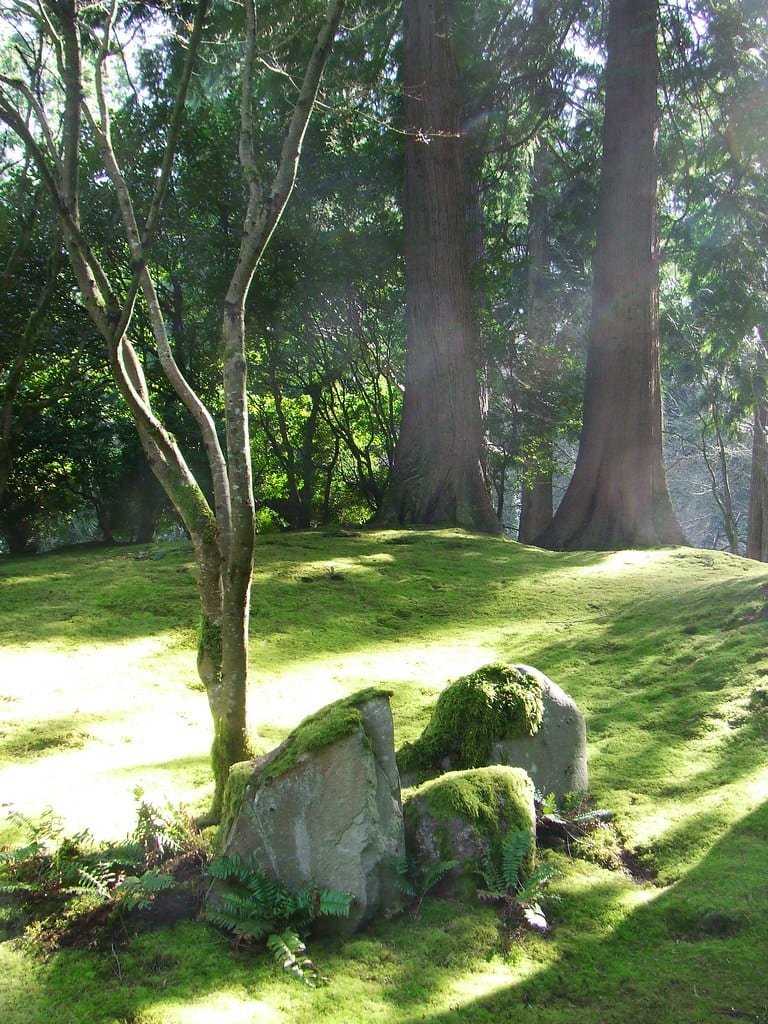“The Light on the Moss” CC
The article written by Oishi Yoshitaka discusses the lofty status of Japanese moss and its degradation due to increasing urbanization. Yoshitaka (2020) begins by detailing the cultural significance of moss in Japan and how its beauty, imperfection, and ephemerality underpin its appeal.
Japan’s abundant rainfall allows for 1,700 varieties of moss to flourish. The centuries-old admiration for moss is not only seen in literature and art, but also in the Japanese gardening techniques of the Muromachi period (1336-1573). The rise of Zen Buddhism during this period also elevated the status of moss by molding the aesthetic taste of the Japanese (Yoshitaka 2020). Imbalance, simplicity and asymmetry came to be valued in many parts of Japanese culture (Hane 2000, 33). Thus, the simplicity of moss came to embody Zen, making it an essential part of Japanese gardening.
Yoshitaka (2020) points us to the diversity of moss within Japanese gardens, which can contain over 100 types of moss and other rare species. Urbanization however has drastically changed the landscape and made it difficult for moss to thrive. For instance, the profusion of concrete and asphalt in urban areas have increased nighttime temperatures and harmed moss colonies. The plant’s sensitivity to the environment warns us of the damage done by climate change. Yoshitaka (2020) highlights that the degradation of moss is representative of the greater environmental consequences that will eventually befall other organisms, humans included. Yoshitaka (2020) ends the article with uncertainty over whether humans will heed the warning signs and avoid greater environmental tragedy.
“Kyoto” CC
This article frames Japan as a “green” nation, calling attention to the collective admiration for moss, cultural prominence, and common concern over its future wellbeing. In this sense, Yoshitaka (2020) conveys how nature is a core component of the Japanese identity and ethos. Japan’s harmonious relationship with nature has been hailed as a model for the rest of the world, especially vis-á-vis the West’s rapacious exploitation of the environment (Kalland and Asquith 1997, 2). For example, Nakamura (1992) posits that the Japanese have a “love [for] mountains, rivers, flowers, birds, grass, and trees, while Murota (1985) contends that “nature is at once a blessing and a friend to the Japanese people” (114; 105). Yet this nature-loving narrative is a superficial account of the nuanced, complex dynamic between Japan and the natural world.
Yoshitaka (2020) describes how the Japanese admire moss for its “subtle beauty” and soothing aesthetic. These qualities make moss a perfect ingredient in the aforementioned Japanese gardens and “carefully-groomed” miniature terrariums (Ibid.). The perception of moss as “earthly loveliness” is a manifestation of the Japanese love for an idealized form of nature (Ibid.). Kalland and Asquith (1997) contextualize this dynamic by means of a “nature continuum,” in which one side is representative of nature that is “tamed” and “pure,” while the other is “wild” and “unbound” (13). Japanese culture is fixated on the former, as it values the “gentle and intimate aspects of nature” rather than its untamed, superfluous characteristics (Kalland and Asquith 1997, 16).
The Japanese obsession with moss is thus ensconced in a deeper cultural understanding of nature is and what it should be, namely a mechanized form that is amenable to viewing and sensitive interaction. This challenges the nature-loving Japanese narrative, as this idealistic view of nature suggests that the Japanese do not really care for the real, untouched natural world. While Yoshitaka (2020) mentions the anthropogenic dangers to both garden and natural moss environments, the presiding cultural norm would suggest that the Japanese would tend more to the urbanized moss gardens than to their natural counterparts.
“Green Carpet” CC
Moss’s importance in Japanese literature and art also evinces the Japanese penchant for idealized nature (Yoshitaka 2020). More specifically, moss is seen as a portrayal of the “human condition” and the natural oscillation between life and death (Ibid.). This exemplifies the Japanese proclivity to use nature as a metaphor for the various emotions and experiences that are present throughout life (Kalland and Asquith 1997, 23). However, this suggests that Japanese literature is similarly predicated on an idealized conception of nature, as pruned moss gardens are utilized to make sense of life’s questions while “real” nature is left unexplored and ignored. As such, the Japanese appreciation for a tamed sense of nature is a type of cultural common thread, running through the physical (e.g. moss gardens) to the intangible (e.g. literature and art).
While the article paints Japan as a “green” society that not only loves moss and nature in general, analysis of Japanese cultural norms challenges this common narrative. That being said, this conclusion is not intended to over-generalize the beliefs of the Japanese people, but rather to complicate prevailing images and ideas.
Word count: 788
Bibliography
“Green Carpet” by tab2_dawa is licensed under CC BY 2.0.
Hane, Kikoso. 2000. Japan: A Short History. Boston: Oneworld Publications.
Kalland, Arne and Pamela J. Asquith. 1997. “Japanese Perceptions of Nature: Ideals and Illusions.” In Japanese Images of Nature: Cultural Perspectives edited by Pamela J. Asquith and Arne Kalland, 2-23. London: Curzon Press.
“Kyoto” by leander.kirsteinheine is licensed under CC BY-NC-SA 2.0.
Murota, Yasuhiro. 1985. “Culture and the Environment in Japan.” Environmental Management 9(2): 105. https://doi.org/10.1007/BF01867110.
Nakamura, Hajime. 1992. “The Idea of Nature in the East in Comparison with the West.” GeoJournal 26(2): 114. https://www.jstor.org/stable/41145342?seq=1.
“The Light on the Moss” by p medved is licensed under CC BY-NC-SA 2.0.
Yoshitaka, Oishi. 2020. “Japan’s Emerald Carpets: The Cultural Importance and Environmental Promise of Moss.” Nippon.com. https://www.nippon.com/en/japan-topics/b02350/japan’s-emerald-carpets-the-cultural-importance-and-environmental-promise-of-moss.html.


